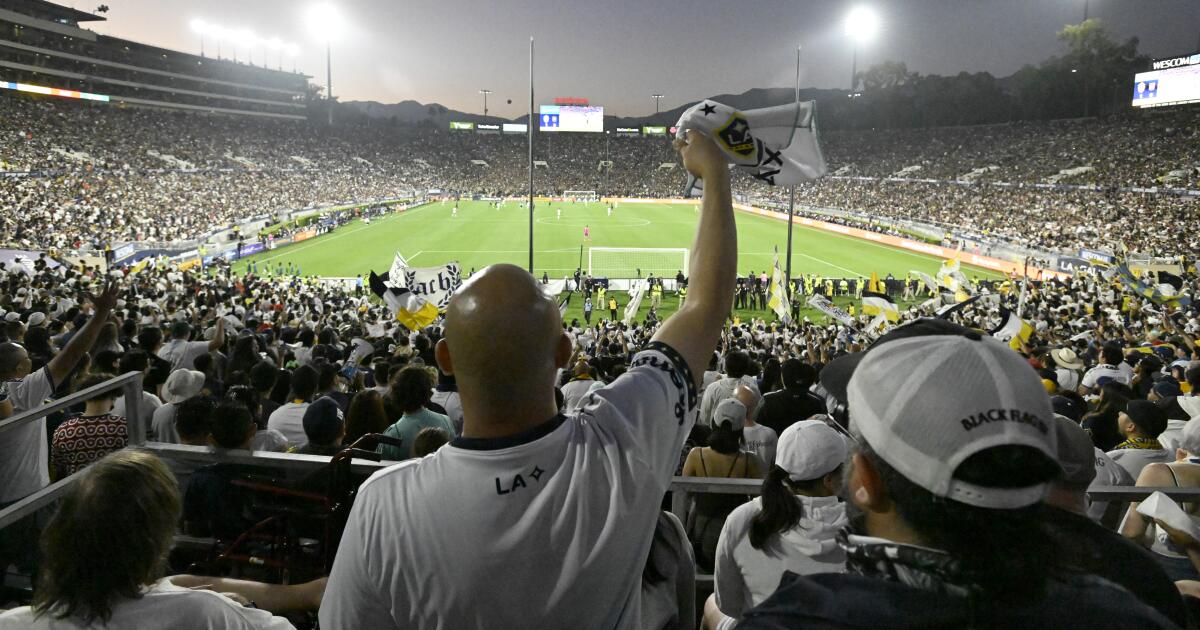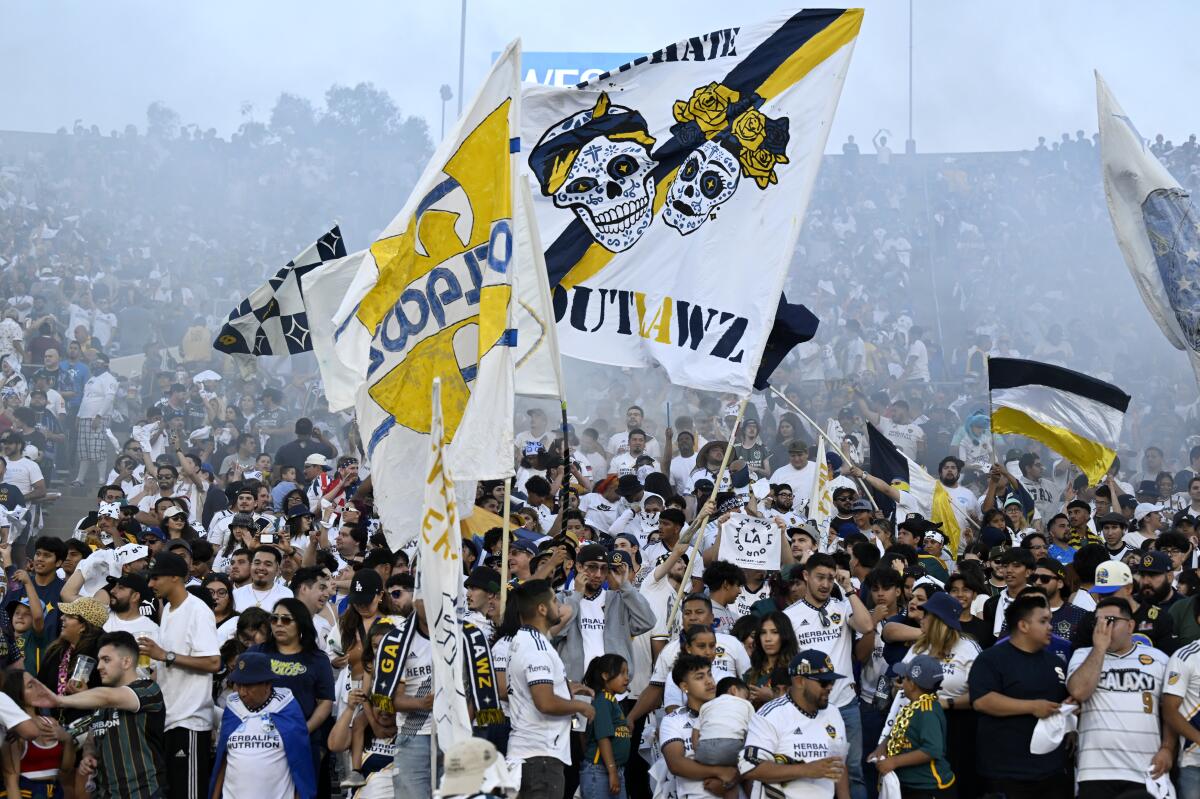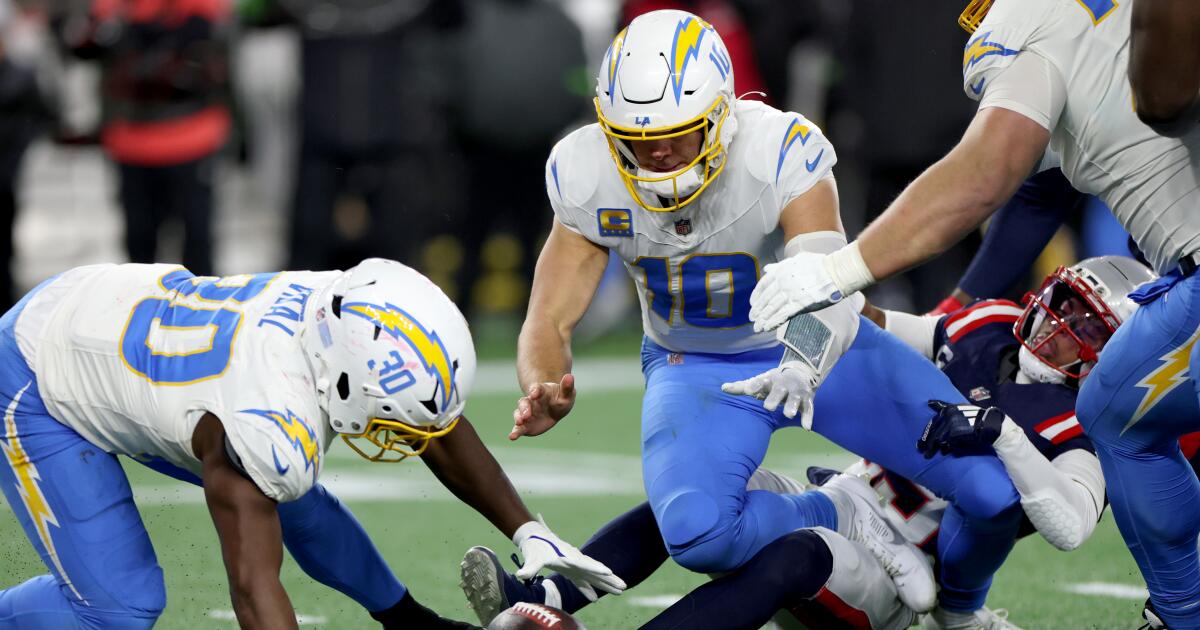Sports
Amid rising MLS popularity, should its teams gamble on bigger stadiums?

Major League Soccer was born 28 years ago in cavernous NFL stadiums. Three seasons later, the league was averaging 14,312 fans a game in venues built to house five times that many.
At most games it was so quiet you could hear each team’s profits drop.
So with the league on the verge of bankruptcy in 2002, clubs began building their own soccer-specific stadiums with smaller grandstands, wider fields and a much better atmosphere. Less than a decade later, more than half the teams played in soccer-specific homes, most with fewer than 26,000 seats. And thanks to that change, MLS not only survived, but began to thrive.
Now, however, with soccer exploding in popularity across the U.S., is the league beginning to outgrow those humble surroundings?
“We don’t think so,” said Camilo Durana, the executive vice-president for properties and events at MLS.
The numbers tell a different story. On Thursday, when the Galaxy and LAFC renew their rivalry at the Rose Bowl, the game could draw as many as 75,000 people, the second-largest crowd in league history behind only the 82,110 the two teams drew at the Rose Bowl last July. That’s more than three times the number of fans they can fit into their soccer-specific stadiums, yet it’s just the crest of a very big attendance wave sweeping through MLS.
A little more than halfway through the season, the league is stretching at the seams, having already drawn more than 6.73 million fans, a jump of more than 7% from this time last year. Twenty-five of the 29 teams are drawing larger crowds than they did last season, while nine teams, including LAFC, are playing to 100% of their stadium’s capacity. Five matches have drawn more than 65,000 people.
Yet while the attendance growth has been impressive, Duran said it’s important to look at more than just the numbers.
“The soccer-specific stadiums provide a lot more than just capacity,” he said. “It’s better sight lines. The camera angles provide a much better broadcast experience. Our clubs can actually own the facility and dictate the schedule. All that delivers a much better experience.
“They can also make decisions on the type of seating available to fans. Standing sections have been wildly successful. That has helped us in the last 24 months to drive attendance up.”
The cozy confines also drive up demand for tickets. The listed attendance for BMO Stadium, where LAFC plays, is 22,000 but the team, which has a season-ticket base of 18,000 and a long waiting list, regularly draws more than that, creating an intimidating atmosphere for visiting teams.
As a result, no team has a better record at home than LAFC since it entered the league in 2018.
LAFC fans show their support during a game against Inter Miami at BMO Stadium in September.
(Francine Orr / Los Angeles Times)
Soccer specific doesn’t have to mean small, however, nor does it mean giving up things like safe-standing sections.
When Nashville SC owner John R. Ingram prepared for his team’s entrance into MLS in 2020, he predicted that soccer attendance would swell and wanted to marry the need for bigger venues with the ambiance of a small building.
“His view was, ‘I want to build this for to where the game’s going, not where it is.’” Ian Ayre, the club’s chief executive officer, related.
The result was Geodis Park, which opened in 2022 with a capacity of 30,000, making it the largest soccer-specific stadium in the league. Two seasons later, Nashville’s average attendance of 28,605 in fifth-best in MLS, trailing four teams that play in NFL stadiums.
“We have 24,000 season-ticket holders and we’ve been sold out of premium [seating] since Day 1,” Ayre said. “So I think we made the right decision. Maybe we need to be bigger.”
Teams with a more modest season-ticket base have chosen to take high-demand games to nearby football stadiums. The San José Earthquakes, who play in PayPal Park, with 18,000 seats, the smallest stadium in the league, have drawn more than double that by playing LAFC at Santa Clara’s Levi’s Stadium and the Galaxy at Stanford Stadium. And Sporting Kansas City attracted 72,610, the third-largest crowd in MLS history, in April when it moved its game with Lionel Messi and Inter Miami — who have combined to drive much of the attendance increase — from tiny Children’s Mercy Park (18,467) to Arrowhead Stadium.
“It does speak to the growth of soccer, the growth of our league and how special it is to be able to do that,” said Galaxy president Tom Braun, who has been instrumental in putting together the two Rose Bowl games.
Still, Durana said MLS isn’t ready to move away from the stadium experience that drove the league to this point.
“The experience for fans is much more than just where they’re seated,” he said. “It’s the food options, what they’re seeing coming into the stadium, rituals that are built into the facility. So a move to a larger venue has a much greater impact on the fan experience.”
It can also be expensive. In most cases, because the MLS teams do not own the larger stadiums, they have to pay rent, give up concession, sponsorship and parking revenue and relocate season-ticket holders. Merchandise stores are different, if they exist at all, as are the food and beverage offerings.
“It’s impossible to co-exist in someone else’s venue,” said Ayre, whose team played its first two seasons in Nissan Stadium, the 69,000-seat home of the NFL’s Tennessee Titans.
If the soccer-specific stadium feels like an old shoe for loyal supporters, the bigger venue may feel foreign and uncomfortable. The same can be said for the players, who have a strange locker room, a different field and a less-intimate atmosphere to get used to. Rarely does the home-field advantage carry over.
“There’s a bit of a gamble,” Braun admitted.

Galaxy fans cheer during a match against LAFC at the Rose Bowl on July 4, 2023.
(Alex Gallardo / For The Times)
In the case of LAFC-Galaxy, moving the game from Dignity Health Sports Park to a larger venue is probably a bet worth taking, though. Not only is the crosstown El Tráfico annually the most passionate rivalry in MLS, but this week there is more that just bragging rights on the line.
The Galaxy (11-3-7) and LAFC (12-4-4) come in tied for the top spot in the Western Conference standings. And while the Galaxy have lost just one of their last 11 matches dating to April, LAFC hasn’t lost in its last nine games, the longest unbeaten streak in the league.
Maybe this game will eventually need a stadium even bigger than the Rose Bowl.
“Dignity Health Sports Park is a special stadium and it’s the best experience in MLS,” Braun said, but “taking the game to the Rose Bowl is a special moment for the league. And it’s just representative of where our league started and where our league is going.
“I can’t say that necessarily big stadiums are the answer. At some point, maybe.”
You have read the latest installment of On Soccer with Kevin Baxter. The weekly column takes you behind the scenes and shines a spotlight on unique stories. Listen to Baxter on this week’s episode of the “Corner of the Galaxy” podcast.

Sports
Patriots crush Chargers in Wild Card defensive slugfest, secure first playoff win since 2018

NEWYou can now listen to Fox News articles!
The New England Patriots defended home turf in the Wild Card Round, dominating the Los Angeles Chargers in a 16-3 victory to move on in the NFL Playoffs.
New England, winning its first playoff game since their 2018 Super Bowl-winning campaign, will await the victor of the No. 4 Houston Texans and No. 5 Pittsburgh Steelers Wild Card game on Monday night to see who they face in the Divisional Round next week.
This game saw its first touchdown in the fourth quarter, but that was because of how suffocating both defenses were in this contest. But it was clear the Patriots had every answer for Justin Herbert and the Chargers’ offense.
CLICK HERE FOR MORE SPORTS COVERAGE ON FOXNEWS.COM
Drake Maye of the New England Patriots celebrates after a touchdown in the third quarter against the Miami Dolphins at Gillette Stadium on January 04, 2026 in Foxborough, Massachusetts. (Winslow Townson/Getty Images)
Mike Vrabel’s squad shouldn’t have given up only three points, especially after Drake Maye was picked off on the Patriots’ second drive at his own 10-yard line. However, the Patriots’ defense was relentless all night, and the Chargers couldn’t adjust.
They stopped the Chargers on four plays to turn them over on downs, and ultimately got on the board first thanks to a 93-yard drive that resulted in a field goal.
49ERS ELMINATE DEFENDING SUPER BOWL CHAMPION EAGLES FROM PLAYOFFS
Los Angeles was knocking at the door again with a third-and-2 from New England’s three-yard line, but Kimani Vidal was stuffed. Cameron Dicker added a field goal to tie the game, and only another Patriots field goal was added to the score before halftime, a 6-3 lead for New England.
While the Chargers couldn’t get anything going on offense, their defense kept them in this game, at least for the first three quarters. Maye was strip-sacked by Odafe Oweh while in Chargers territory to keep it a three-point game in the third quarter.
But after another failed drive, a third Patriots field goal split the uprights to make it 9-3.
Stefon Diggs of the New England Patriots talks to teammates in a huddle prior to an AFC wild card playoff football game against the Los Angeles Chargers at Gillette Stadium on Jan. 11, 2026 in Foxborough, Massachusetts. (Kathryn Riley/Getty Images)
The dagger for the Patriots came after yet another Chargers punt, when Maye placed his pass perfectly for tight end Hunter Henry, the ex-Chargers star, for a 28-yard touchdown. The first six-pointer for either team seemingly ended all hopes for Los Angeles.
On the ensuing drive, Herbert was crushed by K’Lavon Chaisson, resulting in a fumble recovered by Christian Elliss, as the Gillette Stadium crowd went ballistic.
The Chargers tried to get some playoff heroics going, as they dinked and dunked their way down the field into Patriots territory. But on fourth-and-9 from New England’s 34-yard line, Milton Williams ended all hope when he delivered the Patriots’ sixth sack on Herbert to turn them over on downs again.
In the box score, Maye went 17-of-29 through the air for 268 yards, with running back Rhamondre Stevenson being his top receiver with 75 yards on three catches. Kayshon Boutte also added 66 yards on four grabs, while Henry finished with 64 yards.
Drake Maye of the New England Patriots looks to pass prior to an NFL wild card playoff game against the Los Angeles Chargers at Gillette Stadium on Jan. 11, 2026 in Foxborough, Massachusetts. (Michael Owens/Getty Images)
And Maye was also the Patriots’ leading rusher with 67 yards on the ground on nine carries, as he continuously picked his spots to gash the Chargers’ defense.
For Los Angeles, Herbert’s playoff woes continue, as he’s now 0-3 after this performance. He had just 159 yards passing and 57 yards rushing.
Follow Fox News Digital’s sports coverage on X and subscribe to the Fox News Sports Huddle newsletter.
Sports
It’s another one-and-done postseason for Justin Herbert and Chargers

FOXBOROUGH, Mass. — The MVP chants for the second-year quarterback of the New England Patriots rang throughout Gillette Stadium on Sunday night.
The Chargers, meanwhile, were haunted by their own echoes.
Another playoff game. Another one-and-done exit.
The gutty season of quarterback Justin Herbert again ended with a whimper, a 16-3 loss on a night when the Chargers defense provided ample opportunities.
“We have to do better than three points,” Herbert said. “As an offense, that’s not good enough. The quarterback play wasn’t good enough, and we let the defense down today.”
Chargers quarterback Justin Herbert is sacked by New England Patriots linebacker Anfernee Jennings in the fourth quarter Sunday.
(Robert Gauthier / Los Angeles Times)
Three years ago was the nuclear meltdown at Jacksonville, when the Chargers blew a 27-0 lead to lose, 31-30.
Last year, the first under coach Jim Harbaugh, Herbert was picked off four times at Houston after making it through the regular season with just three interceptions.
Now, the Chargers have all offseason to ponder the fiasco at Foxborough, when they generated one field goal, 207 yards and converted one of 10 third downs.
The cover-your-eyes postseason scorecard under Harbaugh: Two games, 15 points on three field goals, one touchdown and a failed conversion.
Asked after the New England loss if the impending offseason changes could include changing out offensive coordinator Greg Roman, Harbaugh was notably noncommittal.
“Right now I don’t have the answers,” Harbaugh said. “We’re going to look at that.”
The juxtaposition between the Chargers and Patriots is stark. The Chargers are precisely where they were a year ago, groping for answers about how to win a postseason game.
The Patriots won just four games last season but bumped that to 14 this year — one of three teams in NFL history to improve by at least 10 games in 12 months — and now advance to play host to Monday night’s winner between Houston and Pittsburgh.
As good as Herbert was all season — particularly playing behind a patchwork offensive line and with a broken left hand — he seemed lost in space Sunday, unable to connect with his receivers or establish anything close to an offensive rhythm.

Former Chargers tight end Hunter Henry catches a touchdown pass in the fourth quarter for the Patriots. It was the game’s only touchdown.
(Robert Gauthier / Los Angeles Times)
He threw for 120 yards and oversaw an offense whose possessions ended thusly: punt, turnover on downs, field goal, punt, end of half, punt, punt, punt, fumble, turnover on downs.
It’s not as if the Patriots were much better. The Chargers largely shut them down on offense, but New England was able to cobble together three field goals and a touchdown by tight end Hunter Henry, who, in a tormenting twist, began his career with the Chargers.
But Patriots quarterback Drake Maye was more calm and in command than Herbert despite two fumbles (one lost) and an interception on a pass that was batted at the line of scrimmage.
“Credit to Drake Maye,” Chargers safety Derwin James Jr. said. “Every time we got to him, he got back up. Every time his team needed a play today, he used his legs.”
In fact, the quarterbacks were the leading rushers, with Maye running for 66 yards and Herbert 57. The Patriots got 53 more from Rhamondre Stevenson, whereas the Chargers couldn’t mount anything of a true running game.
When teams win, they spend the offseason trying to keep their rosters together. When they lose, it’s back to the drawing board. The Chargers are in the latter category.
In a locker room so quiet you could hear a dream drop, linebacker Daiyan Henley said Harbaugh thanked his players after the game.

Chargers quarterback Justin Herbert is slow to get up after being sacked in the fourth quarter against the Patriots on Sunday.
(Robert Gauthier / Los Angeles Times)
“There was a lot of confidence going into this game,” Henley said. “I think the feeling and vibe you’re getting in this locker room right now is that it’s over and that this team is going to change. Everybody is aware that our defense is going to surely change.
“When you have a core group of guys like this, everybody holds a lot of pride in what we do. So to know that we lost and the season is over and this locker room is going to change — and upstairs may change — it hurts more.”
Henley said Harbaugh thanked his players after the game, especially for the way they fought all season despite the various hurdles in their path.
“It sucks because this is how the season ends, so when you talk about processing a loss like this, the process lasts longer,” Henley said.
“You go out on a loss, I’ll be thinking about it until I can go out and get my next win.”
Sports
Packers’ head-coaching situation thrust into spotlight after playoff loss

NEWYou can now listen to Fox News articles!
The Green Bay Packers’ playoff exit on Saturday immediately put added focus on what the organization will do with head coach Matt LaFleur.
The NFL coaching cycle has been the wildest in recent memory, with veteran coaches like John Harbaugh and Pete Carroll being shown the door. Packers fans seemingly put LaFleur on the hot seat following their crushing defeat to the Chicago Bears.
Green Bay Packers head coach Matt LaFleur reacts during the wild-card playoff game against the Bears Saturday, Jan. 10, 2026, in Chicago. (AP Photo/Erin Hooley)
ESPN’s Adam Schefter said Sunday that the Packers will have a major decision to make.
“The Green Bay Packers and their new president, Ed Policy, have a significant decision to make here in the coming days – and that is whether to extend Matt LaFleur’s contract. He’s currently got one year remaining, or to move on from him,” Schefter said. “If they moved on from him, he would automatically go near the top of coaches available and shakeup this current head-coaching cycle yet again.”
Schefter added that Harbaugh could be one of the names that would interest the Packers’ organization.
BEARS’ BEN JOHNSON GIVES FIERY MESSAGE TO TEAM AFTER PLAYOFF WIN: ‘F— THE PACKERS!’
Green Bay Packers head coach Matt LaFleur talks after the playoff game, Saturday, Jan. 10, 2026, in Chicago. (AP Photo/Erin Hooley)
“Notice how we said this belongs to the Packers’ president, Ed Policy. Well, the Packers’ former president from the back in the day was a man by the name of Bob Harlan,” Schefter explained. “Bob Harlan’s son, Brian Harlan, represents John Harbaugh. John Harbaugh is a Midwestern guy, who has a home in the Upper Peninsula, and a lot of people around the league have been wondering if the Packers decide to go in a different direction, if all of a sudden the Green Bay Packers might fall to the top of John Harbaugh’s list as the top available choice for him.
“This has been a wild, crazy coaching cycle, and we may be just scratching the surface.”
Green Bay Packers’ Matthew Golden celebrates his touchdown against the Bears Saturday, Jan. 10, 2026, in Chicago. (AP Photo/Erin Hooley)
CLICK HERE TO DOWNLOAD THE FOX NEWS APP
Green Bay finished 9-7-1 this season. LaFleur is 76-40-1 as the Packers’ head coach with a 3-6 record in the playoffs.
Follow Fox News Digital’s sports coverage on X and subscribe to the Fox News Sports Huddle newsletter.
-

 Detroit, MI1 week ago
Detroit, MI1 week ago2 hospitalized after shooting on Lodge Freeway in Detroit
-

 Technology6 days ago
Technology6 days agoPower bank feature creep is out of control
-

 Dallas, TX4 days ago
Dallas, TX4 days agoAnti-ICE protest outside Dallas City Hall follows deadly shooting in Minneapolis
-

 Delaware3 days ago
Delaware3 days agoMERR responds to dead humpback whale washed up near Bethany Beach
-

 Dallas, TX1 week ago
Dallas, TX1 week agoDefensive coordinator candidates who could improve Cowboys’ brutal secondary in 2026
-

 Iowa6 days ago
Iowa6 days agoPat McAfee praises Audi Crooks, plays hype song for Iowa State star
-

 Montana2 days ago
Montana2 days agoService door of Crans-Montana bar where 40 died in fire was locked from inside, owner says
-

 Health1 week ago
Health1 week agoViral New Year reset routine is helping people adopt healthier habits


















